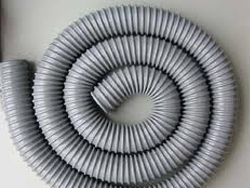If you are looking for an easy to use, cost-effective and effective way to cool down your home or workspace, then a ventilation duct may be just what you need. Used in a wide variety of business and home applications, a ventilation duct may just be the solution you are looking for.
A ventilation duct is also an indispensible tool in the petrochemical industry. In such a scenario, these devices can be used for anything and everything from ventilating storage tanks to providing fresh air to maintenance crews working in pits.
These devices can also be used as part of the equipment list for site maintenance duties. As with the petrochemical industry, a ventilation duct used in this scenario will be largely responsible for providing fresh air to crews working in enclosed spaces where there is much less fresh air available.
The polythene tubing used in ventilation duct construction also means that it is impervious to the effects of most chemicals and industry agents. This makes them ideally suited to industrial settings wherein the equipment is constantly exposed to harsh chemical compounds and the elements. If you want to make sure that your ventilation system can hold up to the most rigorous conditions, it would be wise to invest in a ventilation duct in preference to the other commercially available alternatives.
Flex ducts are other common types of duct ventilation, although they have the notable disadvantage of being prone to condensation buildup. These types of duct ventilation are most often used in residential construction, as they are quite affordable and easy to install. In addition to their condensation issues, these types of duct ventilation are often the least efficient in terms of thermal capability.
Finally, metal duct types of duct ventilation provide the least efficient performance of the three. These systems are typically not insulated at all, and they may be formed into a cylindrical or rectangular shape. The main advantage of these types of duct ventilation is that they are inexpensive, although they too tend to have condensation issues in addition to being leaky and noisy.
Back to Top
Ventilation duct construction
Ventilation ducts can be made out of a wide range of materials, although some of the best systems on the market generally use polythene tubing. As for where such devices are used, the range is quite broad and varied. Some of the settings and situation wherein a ventilation duct is often pressed into service are:- emergency or rescue work
- petrochemical industry
- site maintenance
- agriculture
- general home or office ventilation
- industrial applications
A ventilation duct is also an indispensible tool in the petrochemical industry. In such a scenario, these devices can be used for anything and everything from ventilating storage tanks to providing fresh air to maintenance crews working in pits.
These devices can also be used as part of the equipment list for site maintenance duties. As with the petrochemical industry, a ventilation duct used in this scenario will be largely responsible for providing fresh air to crews working in enclosed spaces where there is much less fresh air available.
Advantages of ventilation duct systems
Although there are a few other ways by which fresh air can be delivered to enclosed spaces, a ventilation duct offers a number of notable advantages. For one thing, they are generally constructed out of lightweight material, which makes them ideally suited for scenarios wherein a ventilation system will need to be assembled, broken down, and transported quickly. In such scenarios, more permanent, bulkier, and heavier ventilation systems will simply be too impractical.The polythene tubing used in ventilation duct construction also means that it is impervious to the effects of most chemicals and industry agents. This makes them ideally suited to industrial settings wherein the equipment is constantly exposed to harsh chemical compounds and the elements. If you want to make sure that your ventilation system can hold up to the most rigorous conditions, it would be wise to invest in a ventilation duct in preference to the other commercially available alternatives.
A comprehensive ventilation solution
A ventilation duct is typically used as part of a more comprehensive ventilation system that may include one or more fans, conduits, and even electrical or fuel driven motors. In such a system, a ventilation duct provides an essential service that few other materials are able to provide. And the best part about such a system is that it can provide you with the ventilation you need at a price that won't break your budget.- fabric
- flex
- metal
Flex ducts are other common types of duct ventilation, although they have the notable disadvantage of being prone to condensation buildup. These types of duct ventilation are most often used in residential construction, as they are quite affordable and easy to install. In addition to their condensation issues, these types of duct ventilation are often the least efficient in terms of thermal capability.
Finally, metal duct types of duct ventilation provide the least efficient performance of the three. These systems are typically not insulated at all, and they may be formed into a cylindrical or rectangular shape. The main advantage of these types of duct ventilation is that they are inexpensive, although they too tend to have condensation issues in addition to being leaky and noisy.
Back to Top
Duct Ventilation

Duct Ventilation Resources
- Home
- Air Ventilation Duct
- Aluminum Ventilation Duct
- Bathroom Ventilation Duct
- Duct Ventilation FAQs
- Flexible Ventilation Duct
- Kitchen Ventilation Duct
- Mine Ventilation Duct
- Types of Duct Ventilation
- Ventilation Duct Supplies
- Ventilation Duct
- Ventilation Duct Cleaning
- Ventilation Duct Design
- Ventilation Duct Sizing
Sponsored Links
